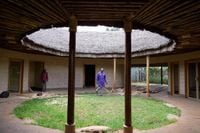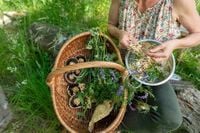In Nairobi, Kenya, a quiet revolution is taking root—quite literally—beneath the city’s bustling surface. On September 12, 2025, a contractor meticulously inspected wall and roof insulation inside a house under construction. But this wasn’t just any construction site. The insulation was made from a blend of agricultural waste and mushroom mycelium, the intricate root structure of fungi, according to an Associated Press report. This innovative material, produced by the local company MycoTile, is at the forefront of a movement to make housing more affordable, sustainable, and accessible in a city grappling with a severe housing crisis.
MycoTile’s approach is simple but groundbreaking: grow fungi on an industrial scale, not for food, but for building homes. The company produces about 3,000 square meters of mycelium-based materials every month. These panels, when combined with natural fibers and binding agents, are used for everything from insulation to interior décor. And they come at a significant discount—roughly two-thirds the price of traditional building materials. For many Kenyans, where the cost of building a simple one-bedroom unit can soar to 150,000 Kenyan shillings (about $1,000), this is a game changer.
Street vendor Jedidah Murugi is one of the first to benefit from this fungi-fueled innovation. Her 15-square-meter home, built with MycoTile panels, cost her just 26,880 Kenyan shillings (about $208). Murugi told the Associated Press, “There is no huge difference in the quality of the houses made from brick and these boards. The only difference is in the cost. My house is not cold at night and neither is it hot during the day.” For many in Nairobi, where over five million residents face a housing deficit of at least two million units, such affordability isn’t just attractive—it’s essential.
Mtamu Kililo, MycoTile’s founder, sees his company’s work as a direct response to Nairobi’s housing crisis. “Introducing affordable materials like ours taps into an existing huge market and contributes to providing affordable housing solutions,” Kililo explained. The savings aren’t just financial. MycoTile’s process uses around 250 tons of agricultural waste annually, reducing pollutants and easing the burden on local waste disposal systems. “We go to western Kenya where there are many sugar manufacturing factories and collect the waste matter. The pasteurized agricultural waste is introduced to the mycelium composite from the farmed mushrooms, binding it into dense panels,” Kililo said.
This isn’t just a local story. The use of mycelium in construction has been gaining ground globally. In May 2024, Namibia saw its first mycelium house built by the nonprofit group MycoHAB, using technology originally developed for NASA. Meanwhile, in the Netherlands, innovators are crafting mushroom coffins by binding mycelium with hemp fiber, creating biodegradable burial options that resemble ancient Egyptian sarcophagi. Sustainable products from biogenic materials are highly desirable, says Nickson Otieno, an architect and sustainability expert in Nairobi, because they “have a low carbon footprint and potentially contribute no emissions.”
Kenya’s government is taking notice. Authorities have recently begun shaping a national plan for decarbonizing construction, with a focus on local innovation. MycoTile is a key player in this vision, collaborating with the Kenya Industrial Research and Development Institute, which provides access to vital machinery and research facilities. The Global Buildings Performance Network, a think tank, warned earlier this year that Kenya “risks locking in decades of carbon-intensive construction” without targeted intervention. MycoTile’s fungi-based panels, which are biodegradable and environmentally harmless, offer a promising alternative.
For Kililo, the journey began during a research fellowship in Kigali, Rwanda, home to one of East Africa’s largest mushroom farms. “The used substrates looked like brick and I thought I could use those in the building industry,” he recalled. Upon returning to Kenya, he experimented in his kitchen, growing fungi in his pantry and baking them in his oven. “Initially it was purely research,” Kililo admitted, but the results soon outgrew his kitchen and became a commercial venture with the potential to reshape Nairobi’s skyline.
But as mushrooms find their way into homes and construction sites, another trend is mushrooming—this time, quite literally, in the fields and forests of the United Kingdom. Foraging for wild foods, especially mushrooms, has become increasingly popular, fueled by social media and a growing desire to reconnect with nature. Yet, with this popularity comes a new set of challenges and warnings.
Last week, the Berks, Bucks and Oxon Wildlife Trust (BBOWT) issued a stark reminder: foraging is not allowed on its reserves. The Trust’s message was clear—picking mushrooms and toadstools disrupts the reproductive cycle of fungi and removes crucial food sources for wildlife. “Mushrooms and toadstools are the reproductive part of the fungus and picking them can stop the fungus from releasing its spores to sustain a healthy population. It also removes hugely important sources of food for a host of wild animals and even other fungi,” BBOWT stated.
Andy Coulson-Phillips, BBOWT’s Principal Ecologist, emphasized the risks: “Our wildlife reserves are home to a number of sensitive and protected species of fungi, and even if they are not the targets for foragers, they can be harmed through trampling and disturbance. We have seen examples of indiscriminate foraging on our reserves where all manner of species have been picked and later discarded if they're not suitable for consumption.” The consequences are real. “While picking blackberries can be a harmless activity when done sensitively, ensuring that plenty is left for wildlife, the lower numbers of fruiting fungi mean that picking just a few mushrooms could be the equivalent of removing an entire blackberry bush,” he explained to The Independent.
Social media has played a double-edged role in the foraging boom. On one hand, it has inspired people to explore the natural world and experiment with wild foods. On the other, it has led to accusations that inexperienced “middle-class foragers” may pose risks to both the environment and themselves. The Association of Foragers, a group promoting safe and sustainable foraging, encourages people to learn with experts. “I lead foraging walks for most of the year and a lot of people come on the walks with little knowledge. But that’s what’s great about doing walks in person—you’re able to inform people about what’s sustainable and what’s legal,” said Liam O’Brien, a Dorset-based foraging guide.
O’Brien recommends newcomers join guided walks through the Association of Foragers to build confidence and learn best practices. “If they learn how to do things respectfully and sustainably and leave some for nature—the animals and the insects as well as other foragers—there’s more than enough to go around,” he said. Liz Shearer, BBOWT’s community engagement director, echoed this sentiment: “Time spent outdoors promotes a deeper connection to nature, but how we interact with nature is more important. Understanding and learning more about nature and foraging is a way to improve knowledge and help you to notice more when outdoors.”
From the construction sites of Nairobi to the woodlands of the UK, mushrooms are at the heart of a debate about sustainability, innovation, and our relationship with the natural world. Whether as a building block for affordable homes or a sought-after delicacy for adventurous foragers, fungi are proving to be both a solution and a challenge for societies seeking to balance progress with preservation.

